The Mondraker Level R electric mountain bike sits in the brand’s ‘super enduro’ category, where the focus of performance is on the downhills. Mondraker claims the bike is more versatile than you’d expect, suggesting it’ll be more than capable when climbing.
Running on 29in wheels front and rear, the Level R shortlisted in our 2022 Bike of the Year awards features Mondraker’s Forward Geometry. This uses short fork offsets matched with short 30mm stems and long reach figures, all claimed to increase stability, while maintaining responsive steering.
Its 170mm of Zero Suspension System rear-wheel travel is damped by Fox’s DHX2 coil-sprung shock, and matched with a 44mm offset Fox 38 fork, boasting 180mm of travel. The Mavic E-Deemax 29 wheels are wrapped in Maxxis DH Casing rubber, further boosting its downhill credentials.
Mondraker has fitted Bosch’s Performance Line CX motor, with a huge 750Wh battery and the smartphone-compatible Kiox 300 display.
Mondraker Level R frame and suspension details
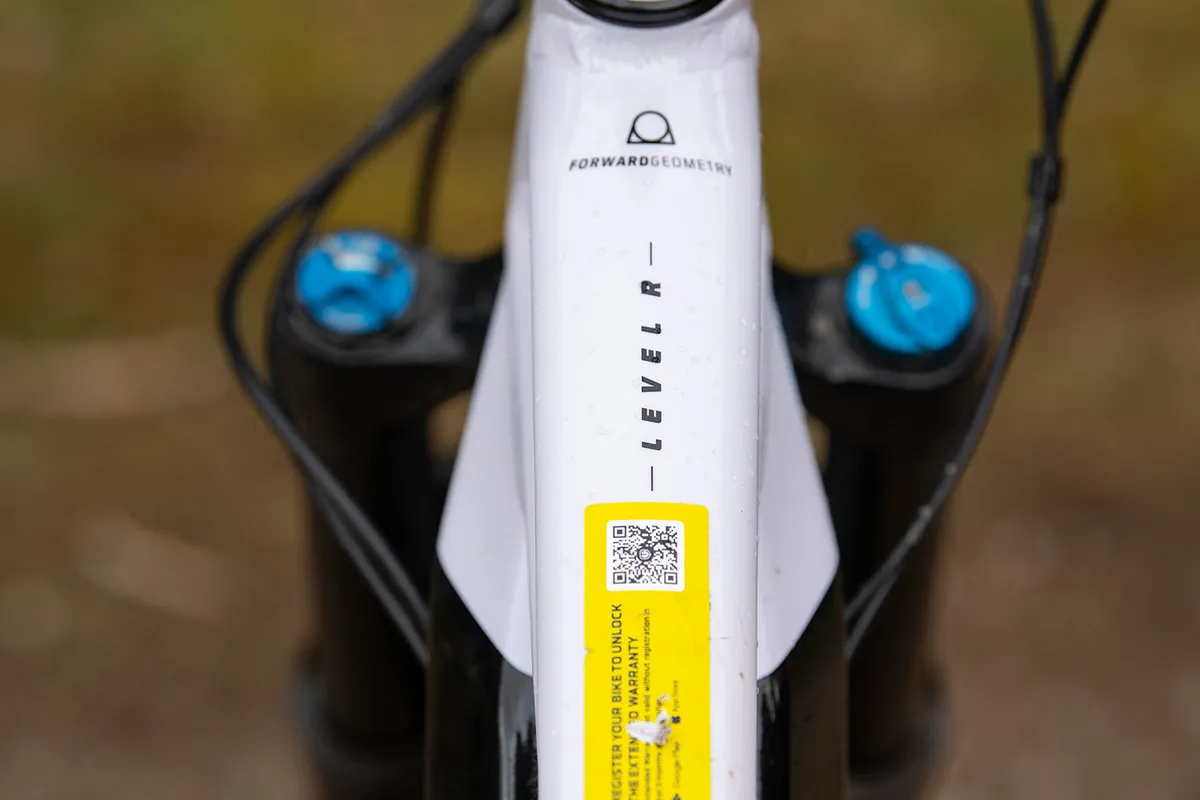
Constructed from Mondraker’s Stealth Alloy, the brand claims each of the bike’s tubes is designed to have the best weight-to-stiffness ratio possible.
The chunky down tube stores the battery. The motor and controller cables, and the brake and gear cables, are all routed internally via down-tube ports.
Accessory mounts feature on the underside of the top tube, but there are no bottle cage mounts, despite there being enough room inside the front triangle.
The chainstay has in-built chain slap protection, while the space underneath the lower linkage is filled with mesh foam to reduce the chances of mud accumulating. The seat tube is straight but has a tapered shape, reducing seatpost insertion depth.
Suspension kinematics
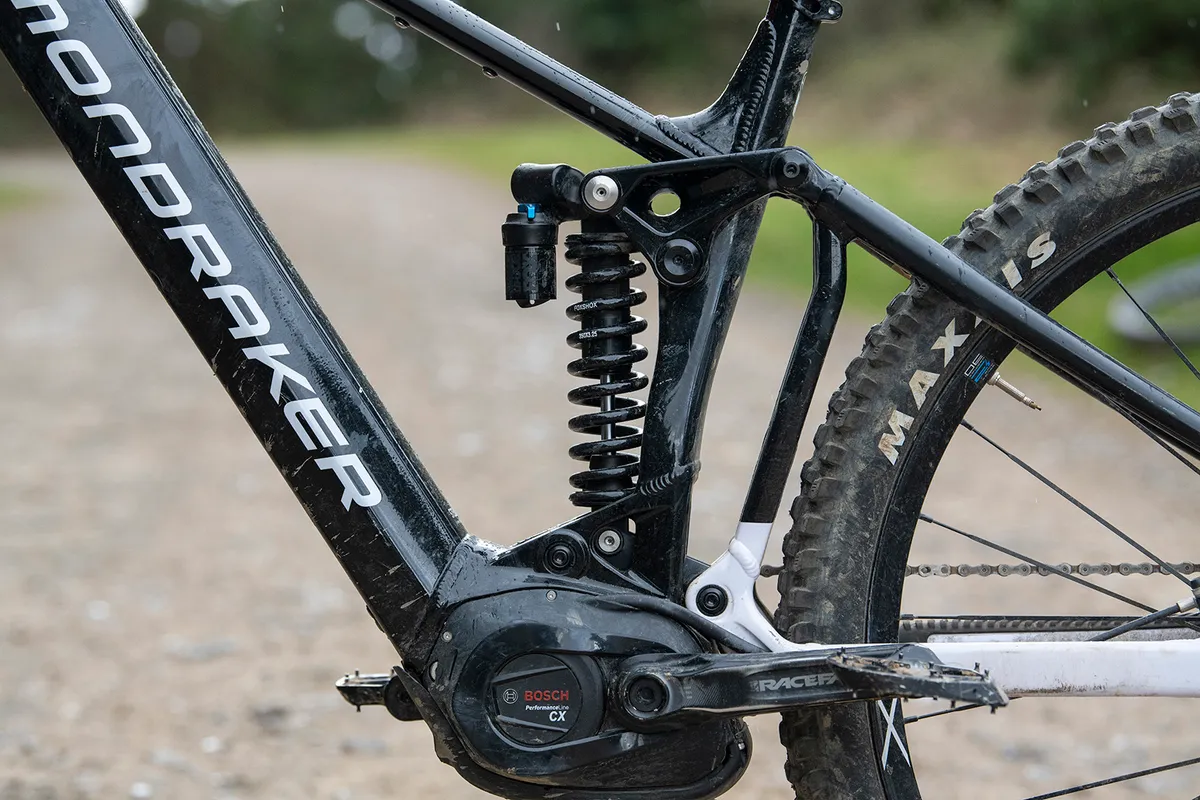
The 170mm of rear-wheel travel is controlled by Mondraker’s dual-link Zero Suspension System, with both linkages compressing the shock from the top and bottom.
Mondraker claims this system enables it to tune the position of the instant centre or virtual pivot point as the bike compresses, influencing anti-squat, anti-rise and progression.
It’s claimed to have minimal chain growth throughout the travel, which should reduce the amount of pedal kickback.
Mondraker claims it has 100 per cent or more anti-squat in each of the bike’s gears throughout its travel range. This means the suspension is less likely to bob under power.
It’s also claimed to have no brake jack, equating to a low anti-rise figure, where the suspension is more likely to extend rather than compress under braking, potentially making it feel more supple.
Mondraker says its beginning stroke is sensitive to improve traction and comfort, while making the suspension progressive through its travel to give mid-stroke support and bottom-out resistance.
According to Mondraker’s own leverage-rate graph, the Level is 18.67 per cent progressive, with a low 2.26:1 leverage ratio thanks to a long stroke shock. The Level R is paired with a coil-sprung rear shock, but is less progressive than rival bikes.
Mondraker Level R battery and motor
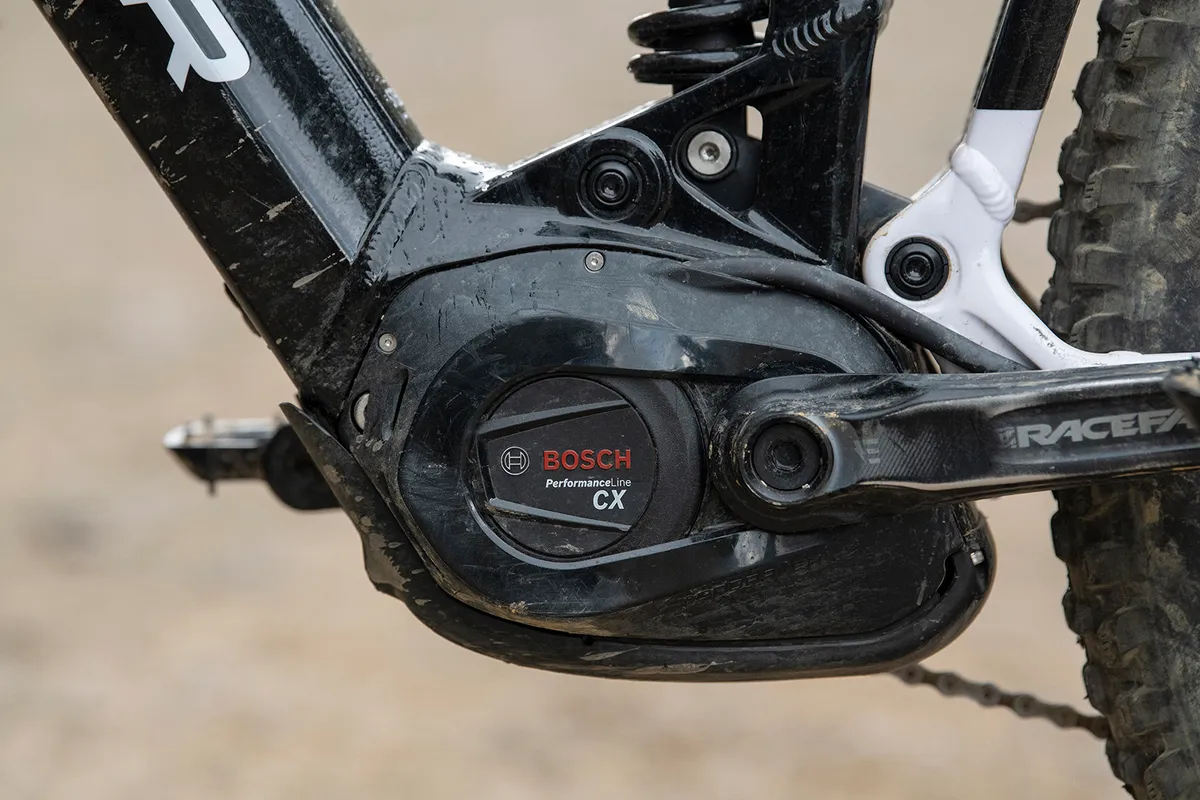
Bosch’s Performance Line CX motor, with the brand’s Smart System and large 750Wh battery, is bolted to the Level R. It boasts 85Nm of torque and 250w of assistance.
This version of Bosch’s motor uses the Kiox 300 full-colour LED display, control unit and LED remote. This can connect to Bosch’s Flow smartphone app, where rides can be recorded and shared, additional ride data displayed, and modes customised.
Unlike Purion-equipped Bosch bikes, the Kiox Smart System has four modes: Eco, Tour+, eMTB and Turbo, plus a walk assist mode. Tour+ provides assistance in a similar way to the eMTB mode – where the harder a rider pedals, the more assistance is provided – but isn’t user-tunable.
Mondraker Level R geometry
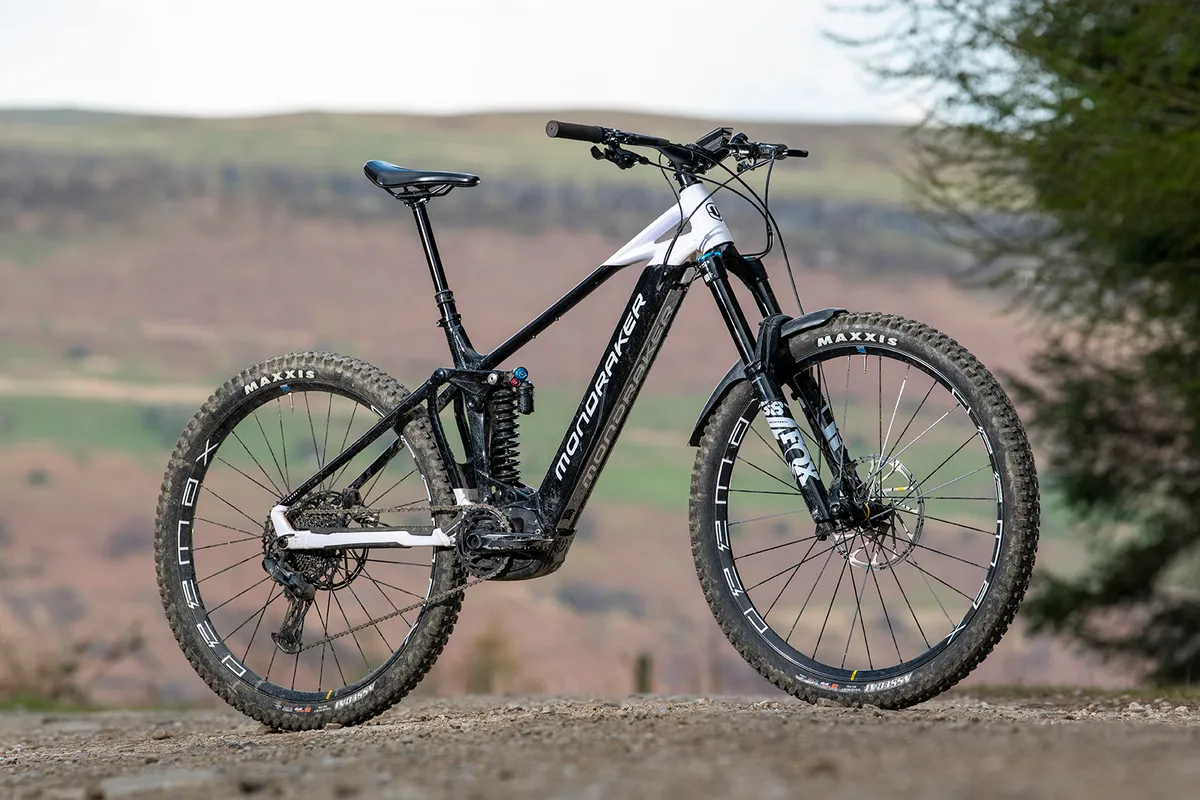
Mondraker’s Forward Geometry concept, where longer reaches are matched with shorter offset forks and shorter stems, has become a widely accepted method of improving bike handling.
The Level R applies this concept in abundance and is available in sizes small to extra-large, with reach figures starting at 450mm and extending to 510mm.
For my 178cm frame, I tested the large Level R with a generous 490mm reach and 30mm stem. It has a fairly low 357mm bottom-bracket height, long 455mm chainstays and a lengthy 1,290mm wheelbase.
Mondraker claims a fairly conservative 65-degree head tube angle, which I measured as 64.6 degrees, and a steep 76.5-degree effective seat tube angle.
| | S | M | L | XL |
|---|---|---|---|---|
| Seat angle (degrees) | 76.5 | 76.5 | 76.5 | 76.5 |
| Head angle (degrees) | 65 | 65 | 65 | 65 |
| Chainstay (mm) | 455 | 455 | 455 | 455 |
| Top tube (mm) | 602 | 622 | 647 | 667 |
| Head tube (mm) | 110 | 110 | 130 | 130 |
| Bottom bracket drop (mm) | 15 | 15 | 15 | 15 |
| Bottom bracket height (mm) | 357 | 357 | 357 | 357 |
| Wheelbase (mm) | 1,250 | 1,270 | 1,290 | 1,310 |
| Stack (mm) | 632 | 632 | 652 | 652 |
| Reach (mm) | 450 | 470 | 490 | 510 |
Mondraker Level R specifications
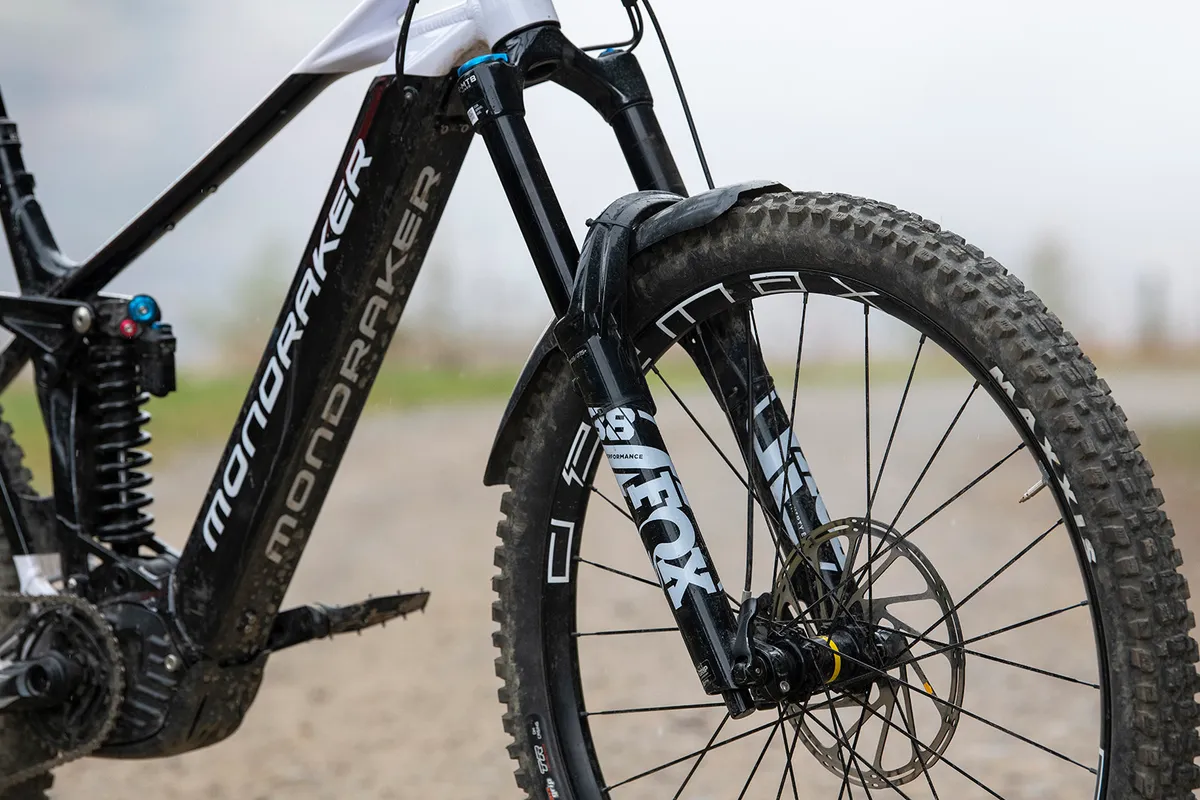
Thanks to components that scream ‘downhill’, Mondraker further cements the Level’s intended use.
Up front is Fox’s impressive 38 Performance fork with GRIP damper and 180mm of travel, matched with a trunnion-mounted DHX2 Performance Elite rear shock, fitted with a 350lb coil spring.
Elsewhere, it has Mavic E-Deemax rims on Mavic hubs, wrapped in DH casing Maxxis Assegai 29x2.5in MaxxGrip compound tyres front and back. This is the toughest and tackiest rubber Maxxis makes.
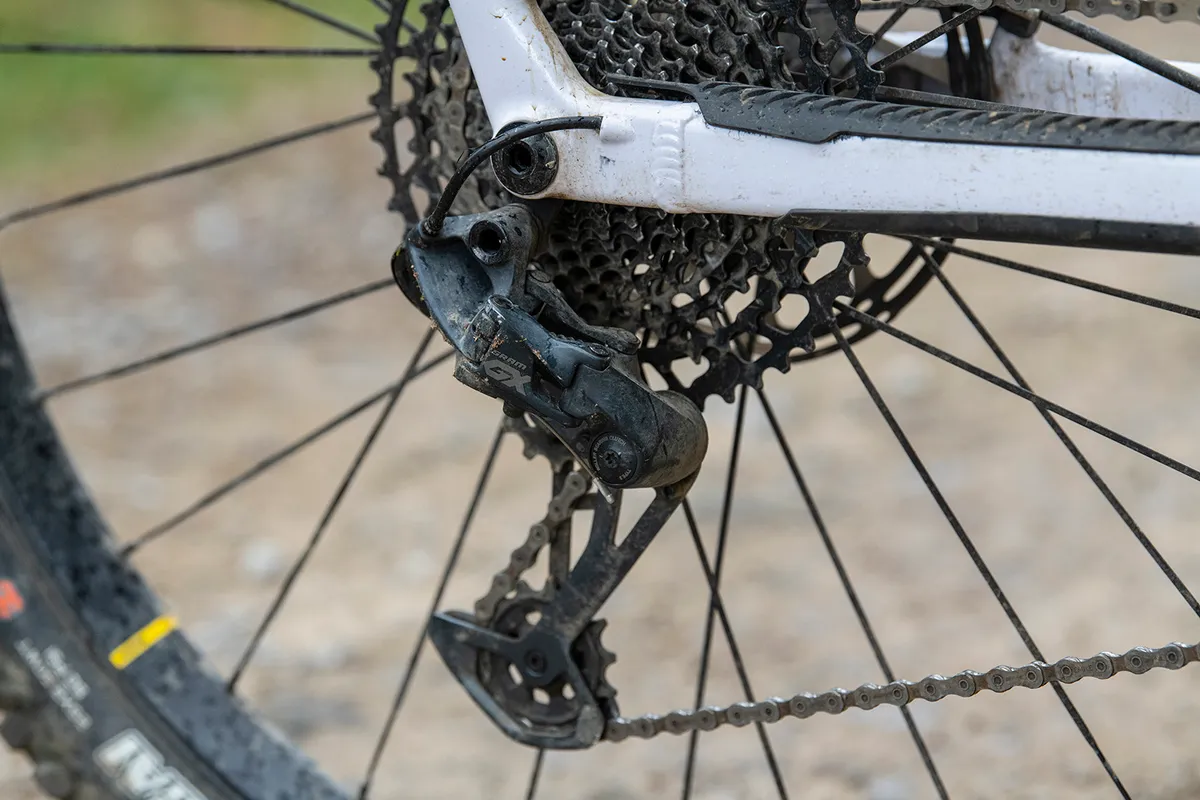
It has a SRAM GX/NX/SX Eagle drivetrain mix and Code R brakes with a large 220mm front rotor and smaller 200mm rear. There are Race Face cranks and a Fizik Terra Aidon X5 saddle.
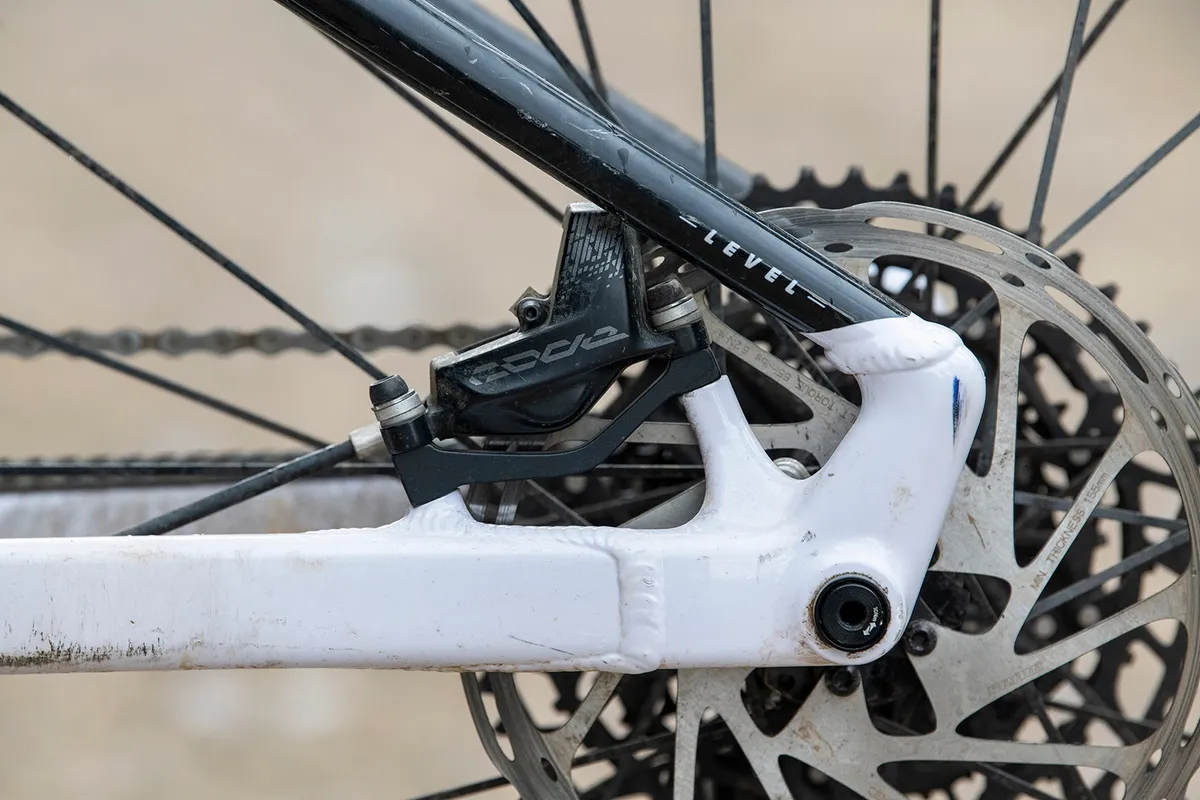
The rest of the finishing kit, including bar, stem, grips and dropper seatpost, comes from ONOFF, Mondraker’s in-house brand.
Without pedals, my large test bike weighed 27.27kg.
Mondraker Level R ride impressions
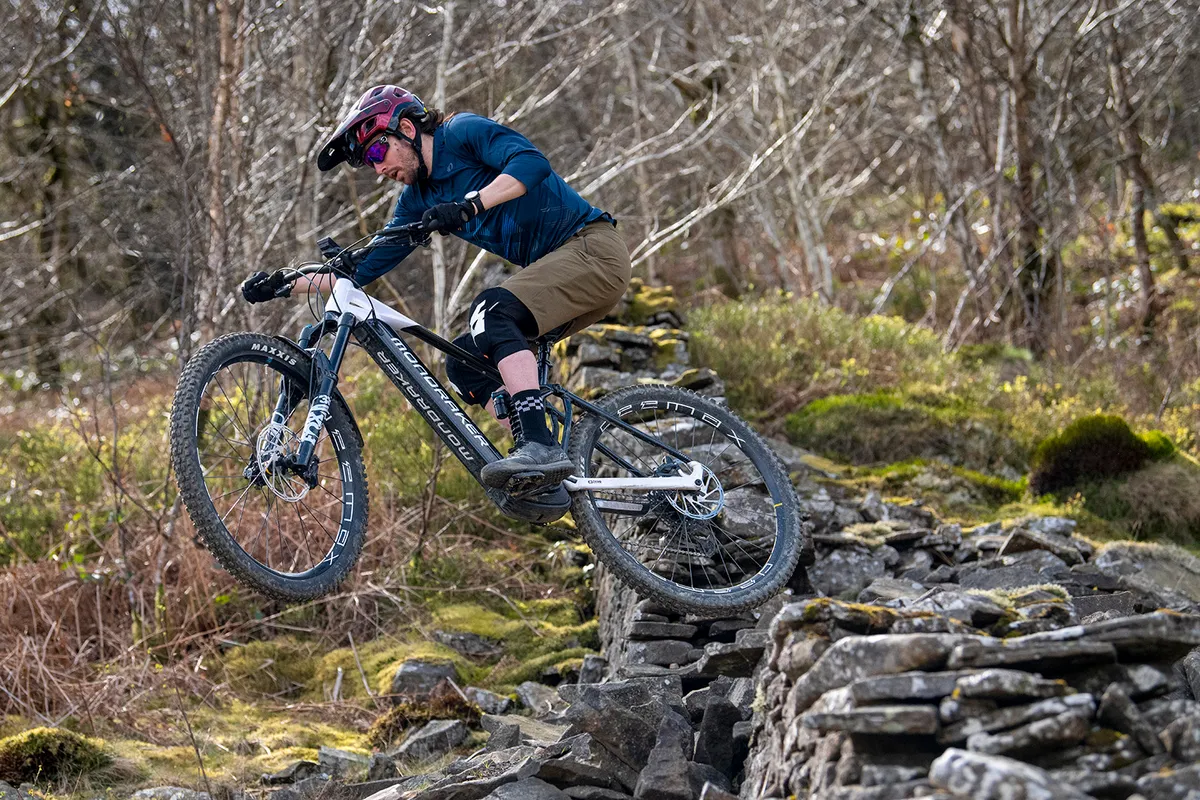
I tested the Level R in Scotland’s Tweed Valley, home to the UK’s round of the Enduro World Series.
I rode the bike on the same trails used for the EWS, which range from ludicrously steep descents through to flat-out DH tracks. Conditions changed from mid-winter slop to warm, dusty and fast-running terrain.
Mondraker Level R setup
I inflated the Fox 38 fork to 98psi and installed three volume-reducer spacers, which gave me 38mm or 21 per cent sag. I set the external rebound adjustment to fully open and left the compression adjuster in the open position for the duration of the test.
The bike came supplied with a 350lb/in spring, which gave me 21mm or 28 per cent sag. During testing, I found this to be perfect for my preferences. However, I set all the shock’s compression and rebound adjusters to fully open.
Thanks to the downhill-casing Maxxis tyres, I was able to inflate them to lower pressures compared to bikes with thinner-casing rubber. Generally, I set the front to 21psi and the rear to 24psi, but went softer if it was particularly wet and harder in dry conditions.
Mondraker Level R climbing performance
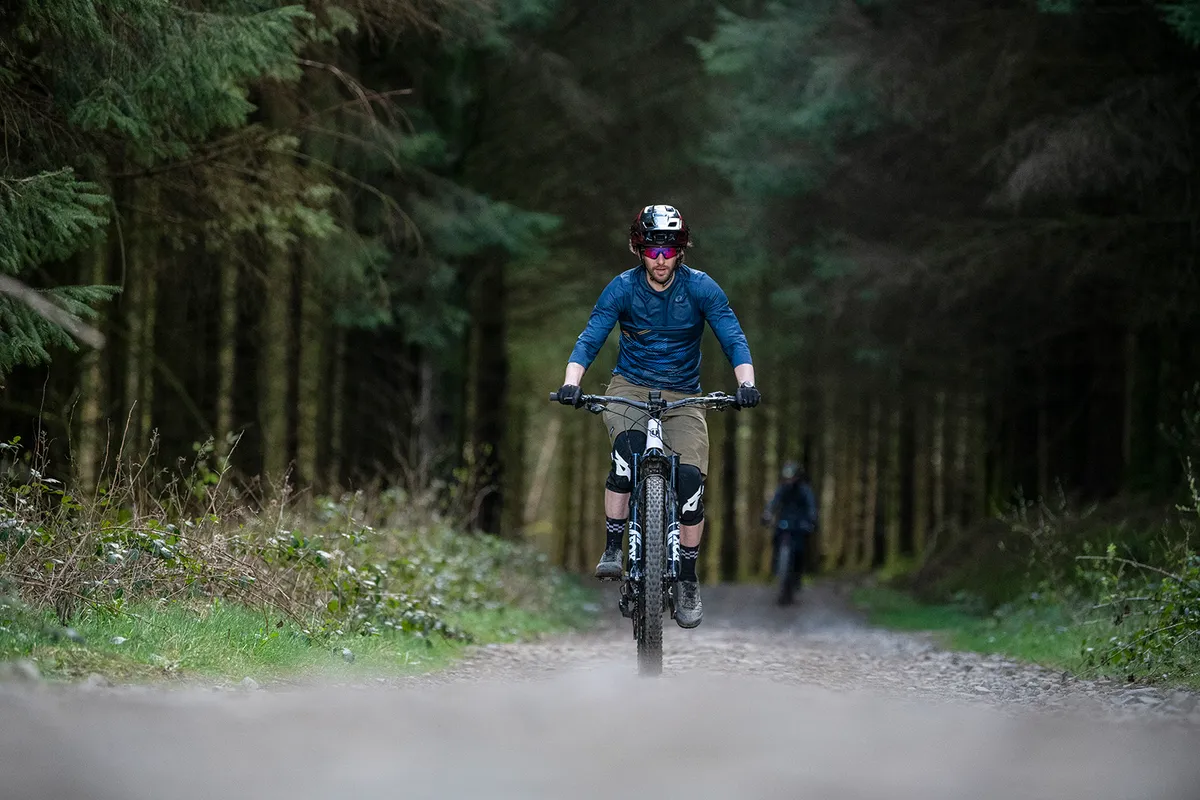
When ascending, the Level R has an aura of calmness, where rider inputs don’t have destabilising effects on its chassis.
The centralised pedalling position is created by its long front and rear centres (the distance between the front wheel axle and bottom bracket, and bottom bracket and rear wheel axle respectively), that help spread a rider’s weight more evenly between the front and back wheels.
Enhancing its ascending prowess further is the steep seat tube angle that placed my hips directly over the bottom bracket rather than behind it. This helped improve climbing comfort and pedalling efficiency.
Combined, these gave the Level R an upright seated riding position, where most of my weight was concentrated through my sit bones rather than my hands. This suited the winch-and-plummet style of riding the Level is designed for.
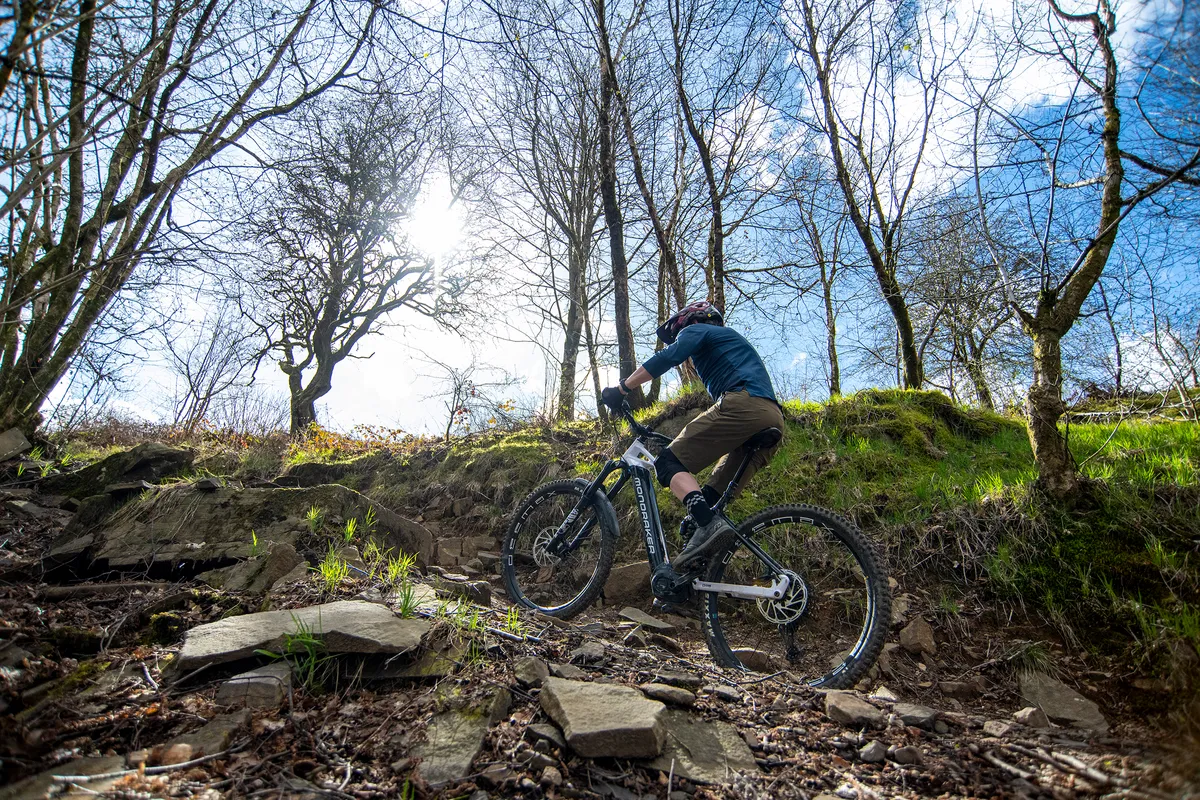
Front-wheel lift on steep ascents was reduced because I wasn’t having to lower myself towards the bars, and traction was also improved, where it was intuitive to feed the motor’s power through the back wheel with small, deliberate weight shifts.
At the start of its travel, the suspension was impressively fluttery and smooth, meaning it did a good job of absorbing small bumps and trail chatter, improving grip and comfort.
However, when pedalling hard over particularly rough terrain with medium to large-sized hits, the rear end could feel choked and less eager to absorb bumps.
Given the leverage rate is less progressive than other bikes that don’t suffer from this problem, it would be safe to bet the anti-squat figures above 100 per cent will be playing a part in stiffening up the rear end.
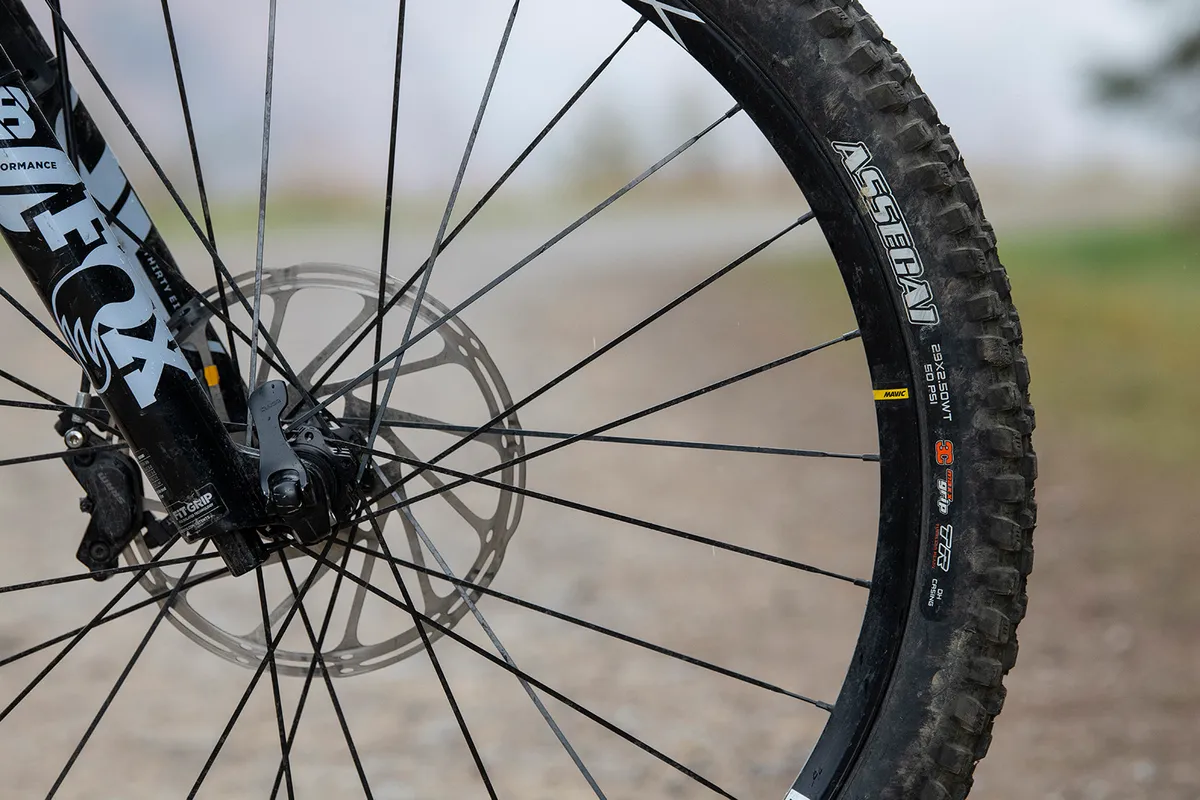
I was able to ride around this by anticipating the larger bumps and unweighting the rear end to go light, rather than crashing through them and relying on the suspension to do the hard work.
The impressively damped and grippy downhill-casing 3C MaxxGrip compound tyres also helped smooth out vibrations and provided immense grip, matching the power of the Bosch motor well.
It is a large bike, however. And while its length is crucial in making it feel calm, the seat tube is also long, with limited post insertion making it feel tall. Shorter people, or those with shorter legs, might struggle to size up to access longer reach figures and still be able to fit on the Level.
Battery life
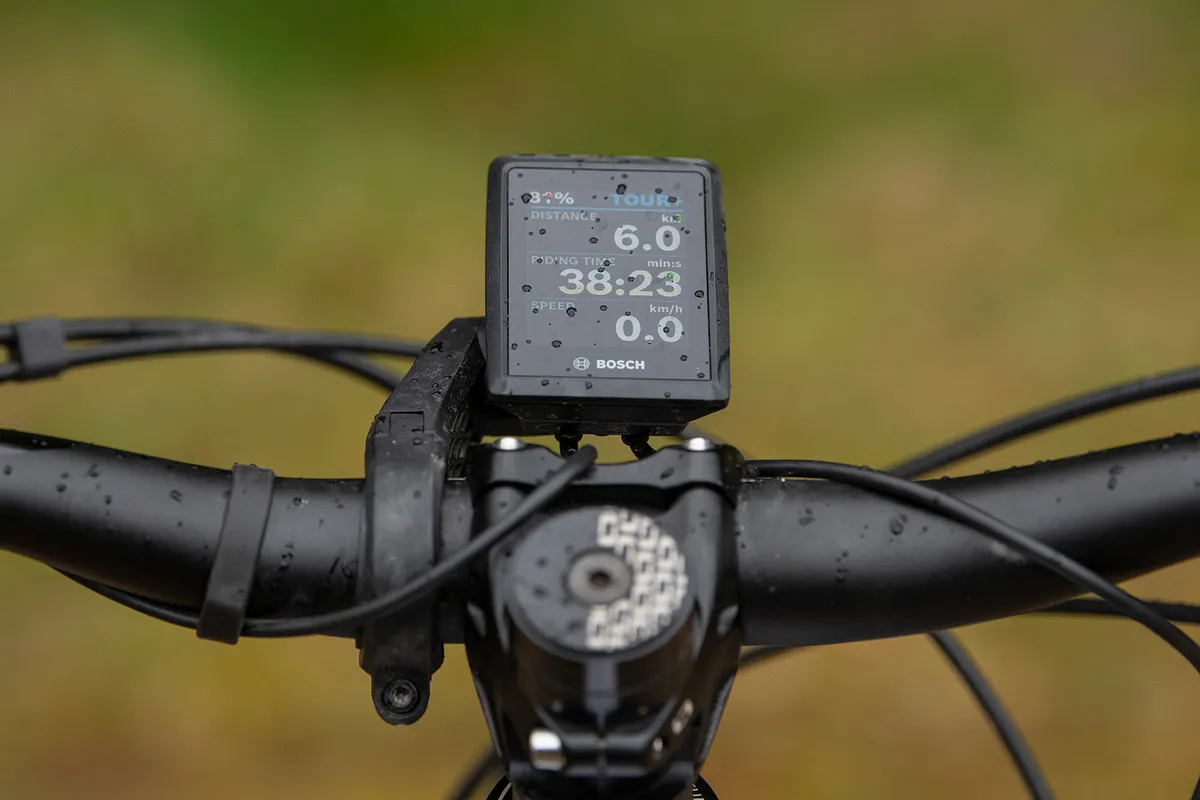
With a battery bigger than its rivals, I expected the Bosch Performance Line CX Smart System motor to deliver an epic range. However, the Mondraker’s weight, thick casing and sticky rubber tyres, and Kiox 300 display combine to drain the battery quickly.
I was lucky to exceed 1,300m of climbing in eMTB or turbo modes, while getting over 1,500m was just about possible in trail+. Eco proved to be more frugal, but thanks to that weight figure, I was working much harder compared to lighter bikes.
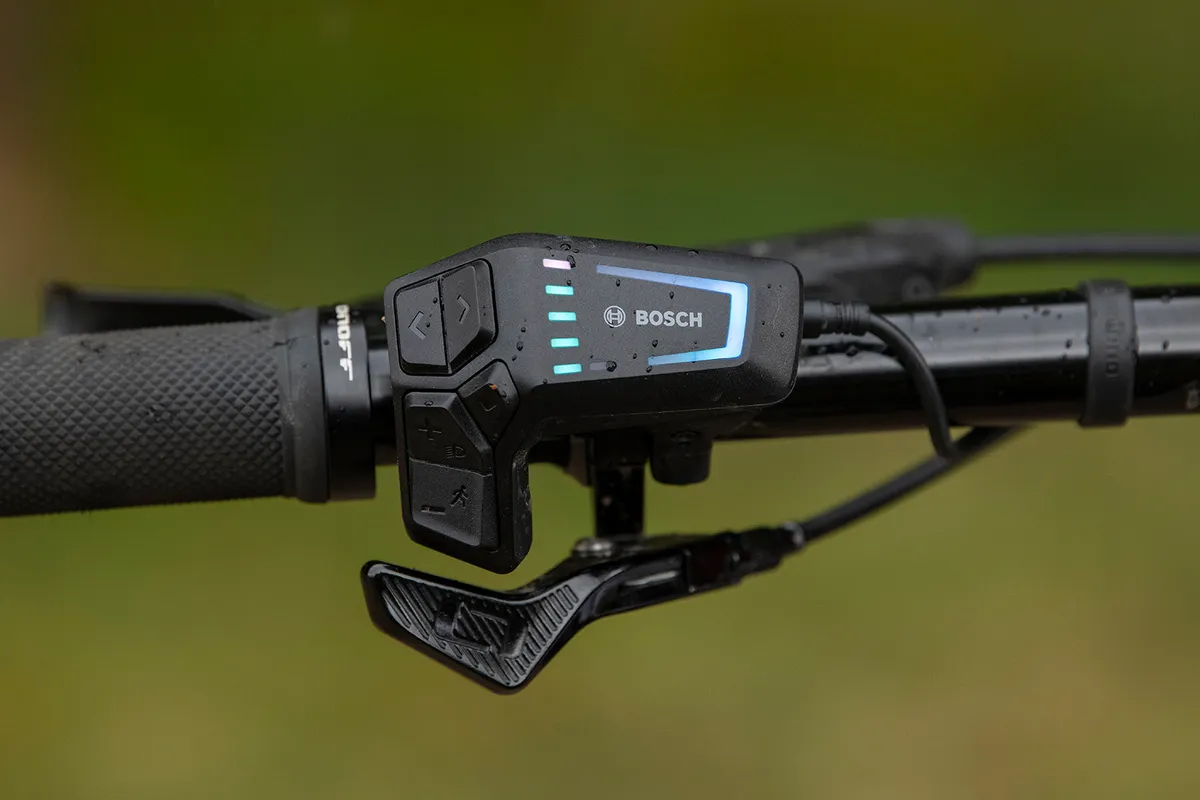
Even with the bike turned on but stationary, a single per cent of battery would drain in 10 to 20 minutes.
In the higher assistance modes, the Bosch motor felt incredible, providing a peppy, natural-feeling ride. Although it proved to be less economical than the EP8, it was certainly more powerful, also beating the motors on the Specialized and Giant bikes in this Bike of the Year category in terms of grunt.
Mondraker Level R descending performance
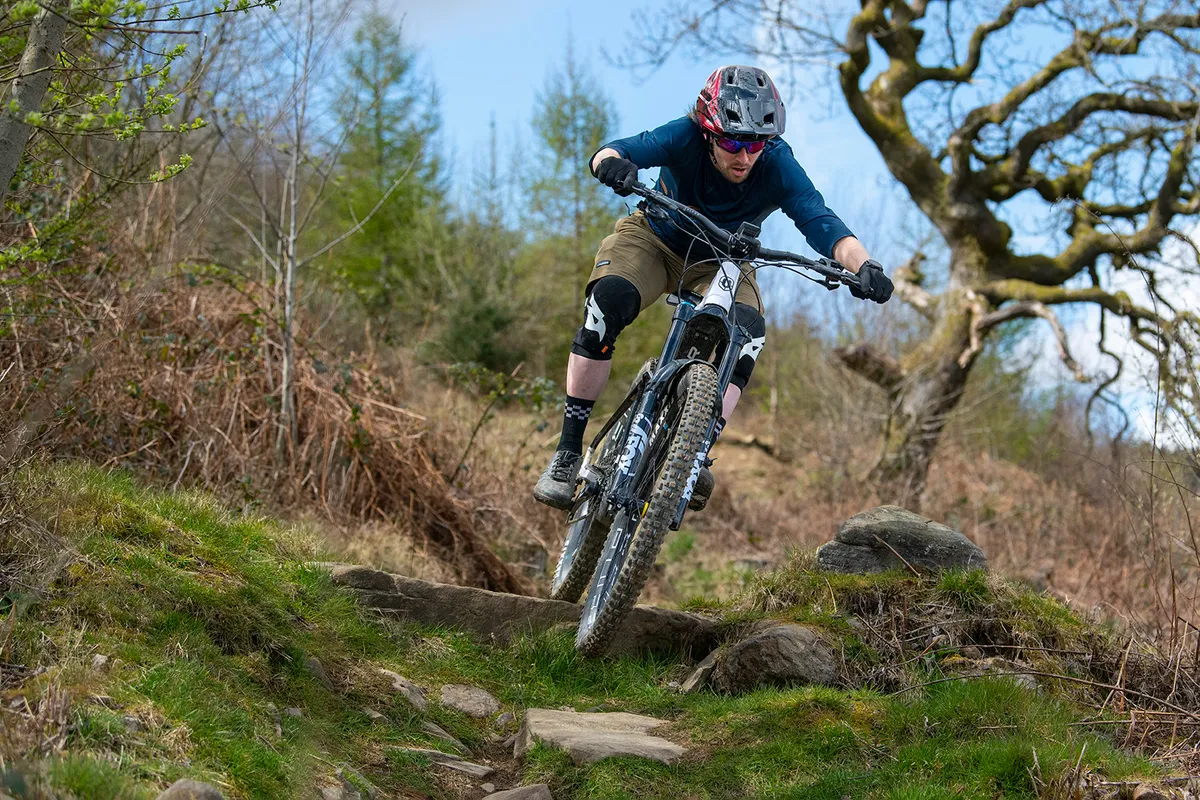
Despite the headline weight figure, the Level R was sprightly but well-behaved heading downhill, for the most part.
It certainly felt calm and composed on steeper or faster terrain, where the long wheelbase, reach and chainstays all played their part in reducing see-sawing and chassis destabilisation caused by bumps.
This meant I was doing less work to keep the bike level and in control, giving it a calm ride.
In turn, this reduced fatigue and allowed me to concentrate on choosing lines, going faster and having more fun.
In tighter turns, it was also surprisingly easy to handle. The head tube angle – that’s arguably steeper than you’d expect on a bike with the rest of its geometry figures – and short stem helped keep steering quick and sharp, especially in steeper turns where the forks were compressed by my weight, further steepening it.
Impressively, the steep head tube angle didn’t cause the front wheel to tuck, which is sometimes a problem on steeper bikes.
The fork’s air spring and impressive GRIP damper – that arguably feels better than the GRIP2 in the 38 – contributed to keeping the front end from diving too far into its travel, preserving steering control.
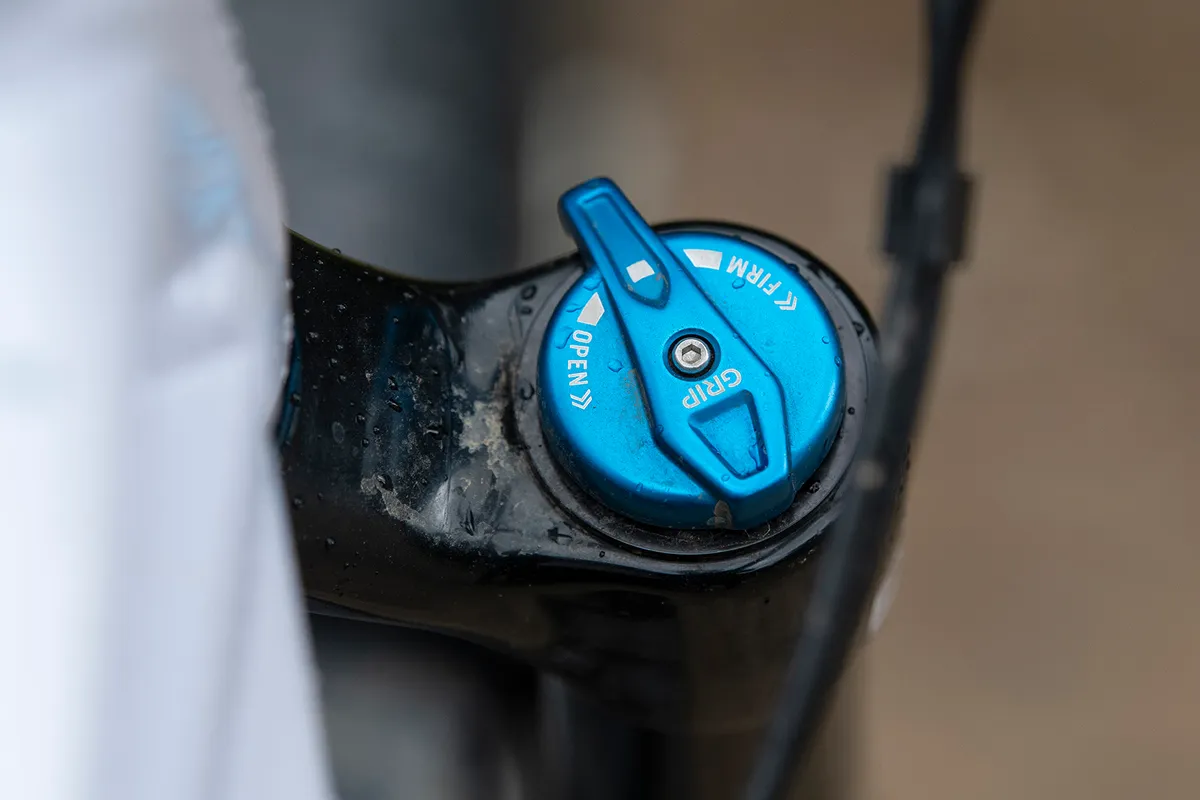
This also meant my weight could be over the front of the bike to aid control without the steering becoming twitchy.
The Mondraker is one of the few bikes where I wouldn’t want a slacker head angle, given its weight and other geometry numbers, and its geometry makes the Level R massively capable on the downhills.
Like on the ascents, the rear suspension felt supple for a vast majority of the time, and seemed keen to absorb smaller bumps and trail chatter well.
This gave it a smooth, grip-abundant ride that made sticking lines over rocky, rooty and bumpy terrain very rewarding.
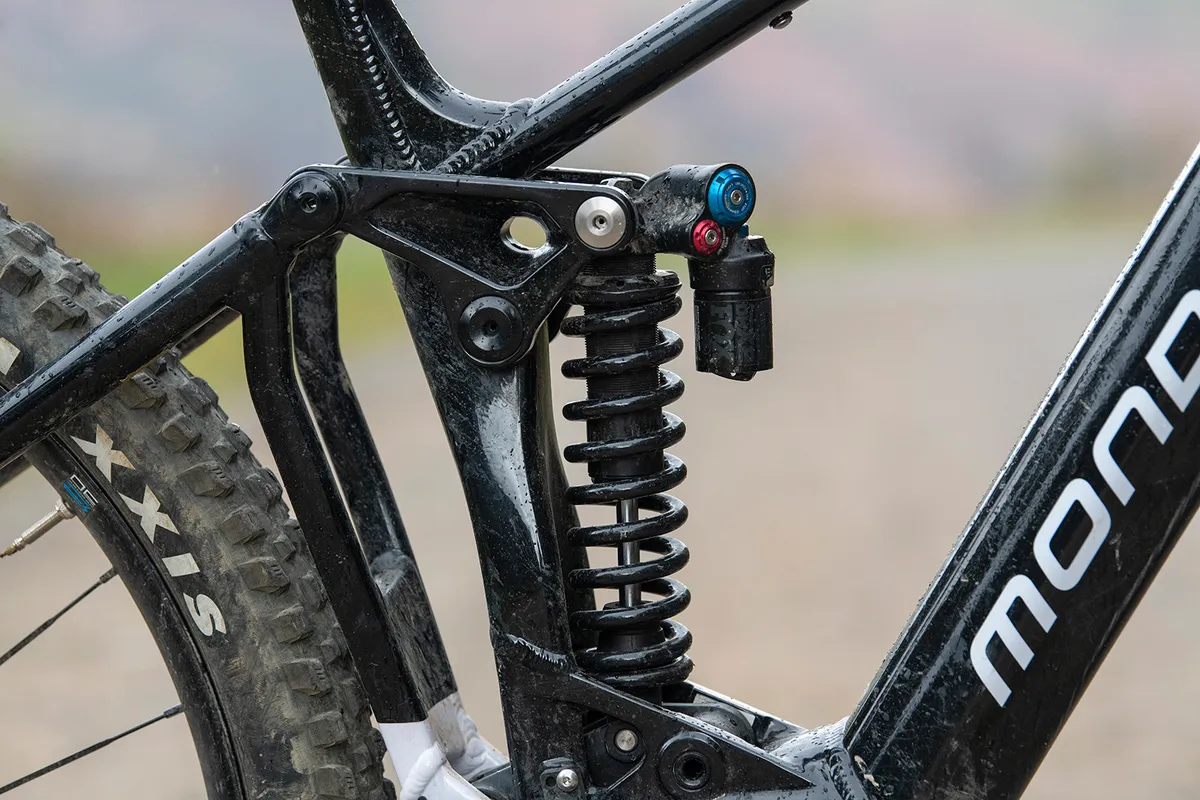
On larger drops to flat, it also had plenty of ramp-up, not bottoming out harshly or eating too much of its travel unnecessarily. There was also plenty of mid-stroke support in berms and when riding through compressions.
However, in scenarios when I was putting force through the pedals, causing the chain to tension – such as pumping a bump or riding with straighter legs – the rear suspension could feel harsh and unable to absorb bumps, frequently causing the rear wheel to emit a donging sound as it hit into the terrain.
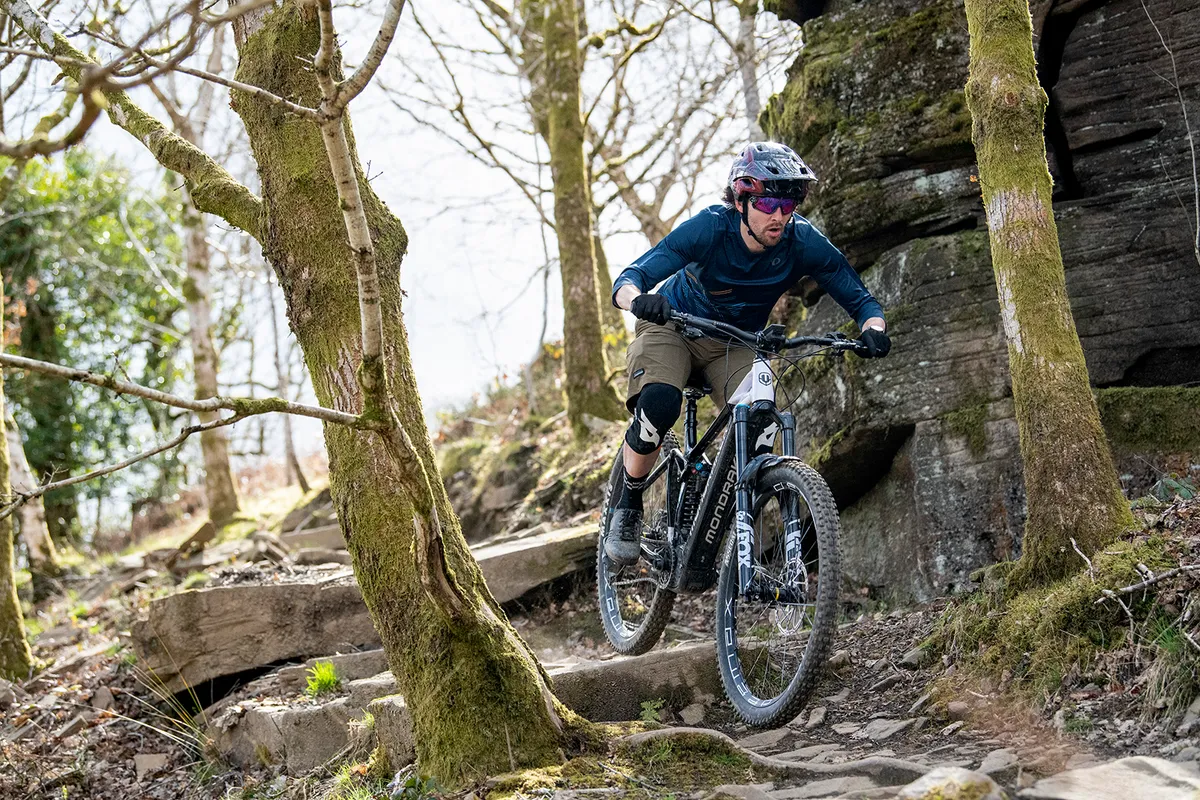
After 60km, many of the Mavic rear wheel’s spokes had de-tensioned, evidence it was having to absorb a large portion of the terrain that the rear suspension couldn’t.
Even after tightening the spokes, a few rides later they would begin to lose tension. While this could be an issue with the rear-wheel build, I suspect it’s more likely down to the rear end not tracking the ground as well as it could.
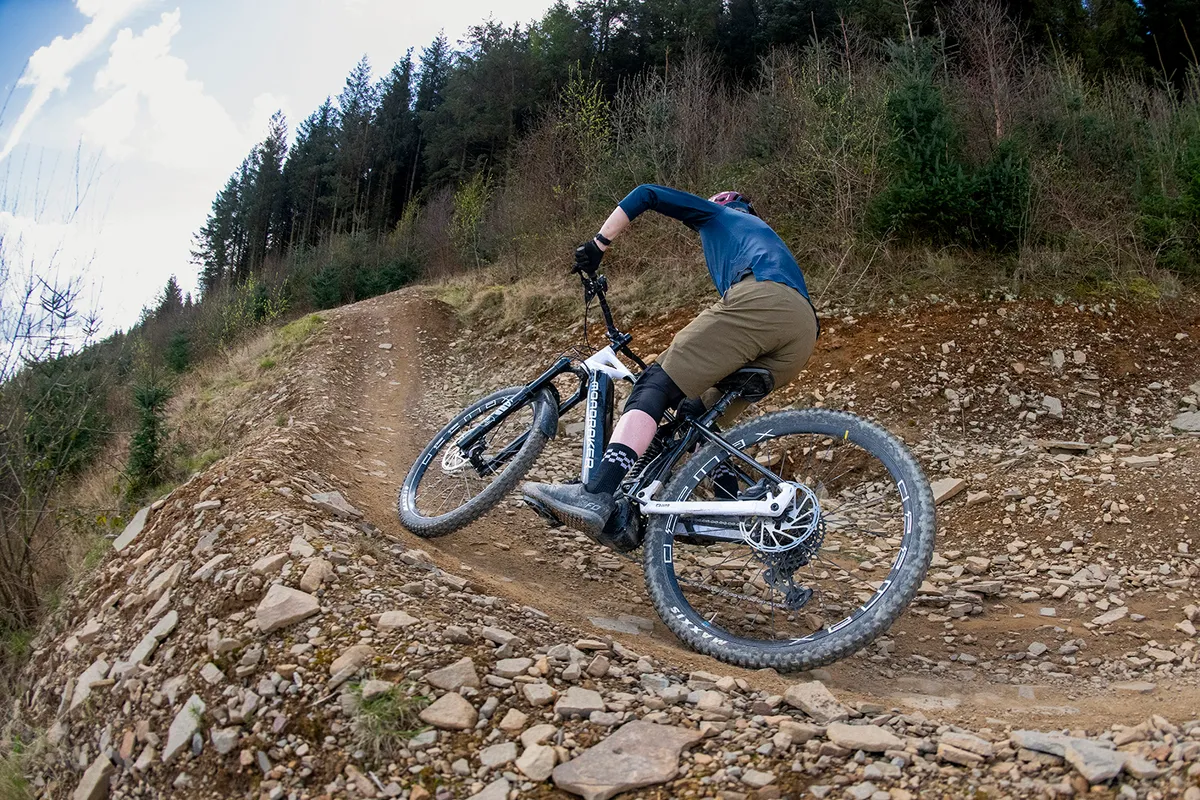
The tyres also played their part in improving the Level’s downhill demeanour. The thick, damped carcasses did a great job of insulating some of the bumps the rear end couldn’t absorb and were worth the weight and battery-life penalties elsewhere in terms of grip and puncture protection.
Other brands take note, these tyres are appropriate for enduro-style ebikes.
How does the Mondraker Level R compare?
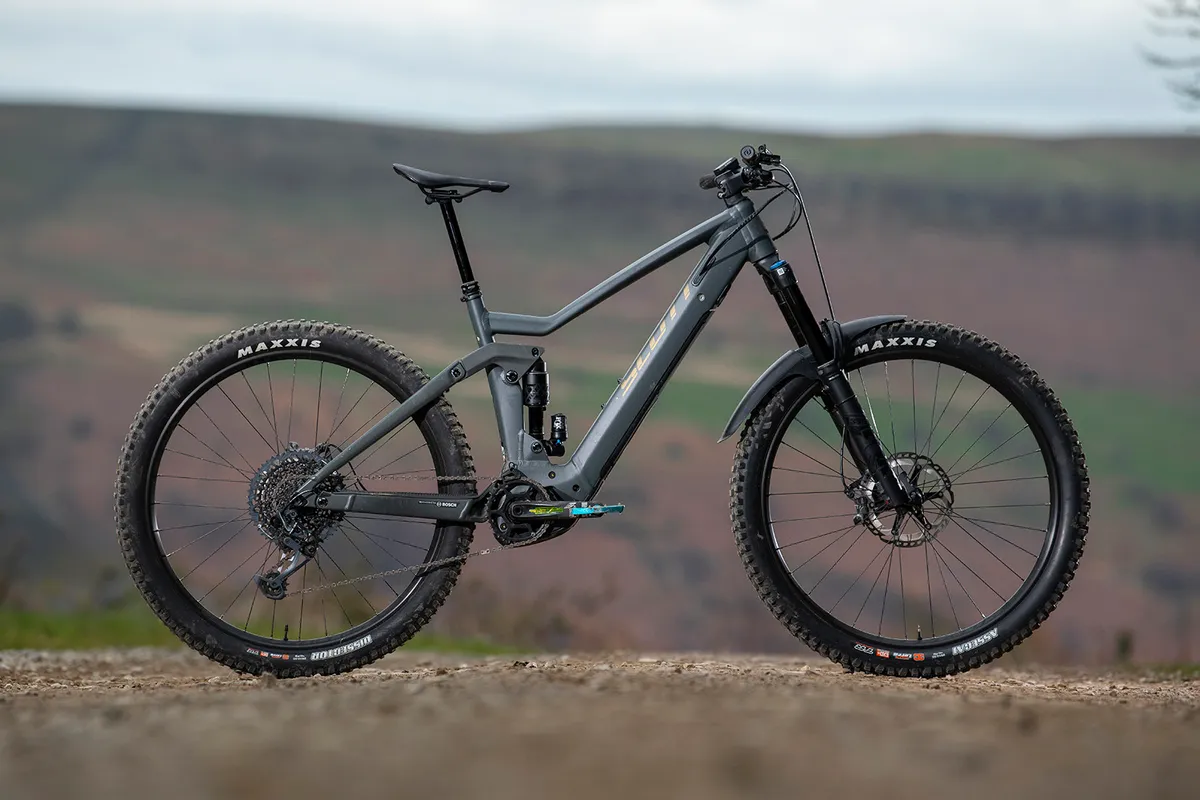
In terms of travel, the Scott Ransom eRide 910 and Nukeproof Megawatt 297 Factory (XT) are direct competitors. Despite that, each bike has its own character, with the Level R feeling as though it has the most travel and composure of the three.
Its tyres certainly influence its ride quality a lot, especially compared to the Ransom, which is arguably under-tyred.
Against the Megawatt, the Level R is more plough and less fun, even though the Nukeproof’s suspension feels better through the entire travel range.
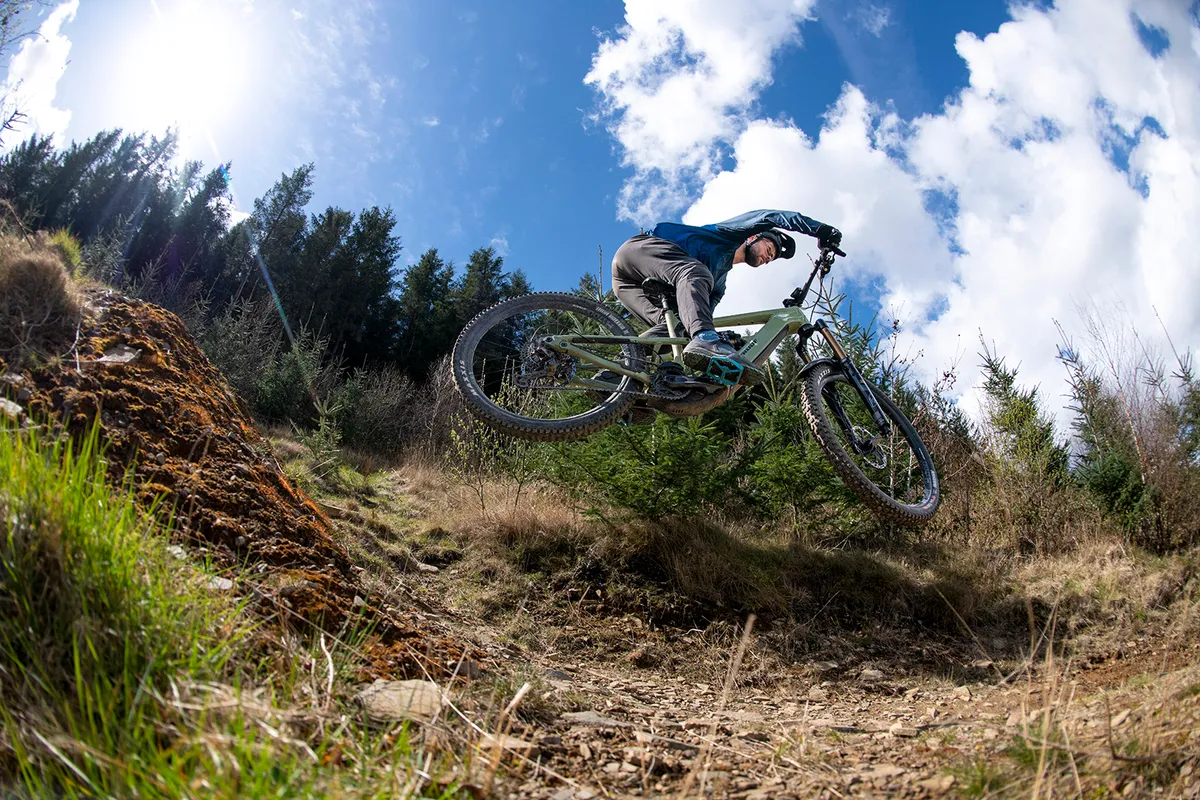
A lot of its fun ride quality is down to the Nukeproof’s lower weight, shorter chainstay figure and 27.5in rear wheel.
For some people, its 27.27kg weight will be a negative, for others it will be a benefit.
Battery life was disappointing, given the 750Wh headline capacity is 20 per cent bigger than the other Bosch ebikes’ 625Wh batteries in this test.
For the extra weight, there wasn’t a 20 per cent increase in range. Swapping out to lighter, less tacky tyres would help improve its life, but this would negatively impact other elements of the bike’s ride.
Mondraker Level R bottom line
If you tend to hammer down the steepest, gnarliest or fastest tracks, the Level R is a real performer, outshining a lot of other bikes designed to do the same thing.
It’s less of a generalist though, and flowy, flatter trails aren’t as engaging to ride as on lighter-weight counterparts.
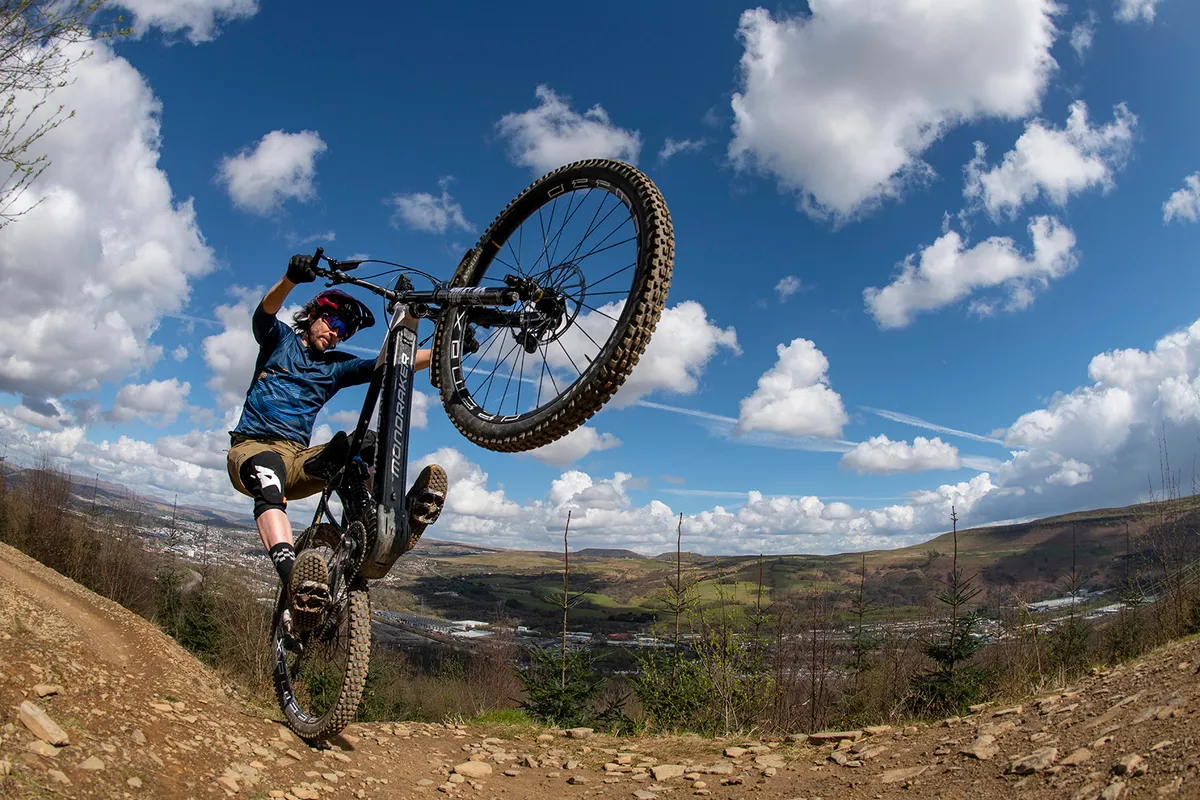
Its suspension isn’t without a few quirks, with harsh reverberations caused by bumps getting transmitted through the frame or punishing the back wheel more than on other bikes. However, at the start of its travel, it’s supple and gives plenty of grip.
The Bosch motor is fantastically powerful, but on this bike it seems to be inefficient. Whether that’s down to the Smart System or the spec is hard to pinpoint.
If you want a hard charger with a descending bias, the Level R is a great bike and reasonably priced.
How we tested
Despite this being the inaugural edition of eMTB Bike of the Year test, we’ve had plenty of experience testing ebikes to their absolute limits. That means finding out which of these eight bikes is the best electric mountain bike currently on sale was made a little easier.
Although that’s not say our job was simple, and choosing a winner came down to the wire, where the second and first place bikes swapped positions more times than we checked our tyre and shock pressures.
The majority of the ebike testing happened in Scotland’s Tweed Valley, home to the legendary Glentress trail centre, Golfie enduro tracks and Innerleithen downhill runs. The terrain we tested the bikes on, therefore, was wide in scope and representative of what a modern enduro bike should be able to handle, whether that was gravity-fuelled laps on the DH tracks, epic enduro missions with long descents or gruelling trail rides with hours in the saddle.
To win this year’s test, we were looking for a bike that offered the best all-round package with fewest compromises and was able to perform on every type of riding we could throw at it. In an ode to a bike tester’s cliché, it had to descend like a downhill bike, pedal and climb like a cross-country bike and be as comfortable to ride as an enduro bike.
Our 2022 eMTB Bike of the Year contenders are:
Product
| Brand | mondraker |
| Price | 5999.00 GBP |
| Weight | 27.2700, KILOGRAM (L) - without pedals |
Features
| Fork | Fox 38 Float GRIP EVOL, 180mm (7in) travel |
| br_stem | ONOFF Sulfur, 30mm |
| br_chain | SRAM SX Eagle |
| br_frame | Stealth Alloy Evo, 170mm (6.7in) travel |
| br_motor | Bosch Performance Line CX/Bosch Powertube 750Wh/Bosch Kiox 300 |
| Tyres | Maxxis Assegai 3C Maxx Grip DH Casing TR WT 29x2.5in (f), Maxxis Assegai 3C Maxx Grip DH Casing TR WT 29x2.5in (r) |
| br_brakes | SRAM Code R, 220/200mm rotors |
| br_cranks | Race Face Aeffect ebike, 34t |
| br_saddle | Fizik Terra Aidon X5 |
| br_wheels | Mavic E-Deemax 29 on Mavic hubs |
| br_headset | ONOFF Saturn Tapered |
| br_shifter | SRAM NX Eagle |
| br_cassette | SRAM PG-1210, 10-52t |
| br_seatpost | ONOFF Pija (dropper) |
| br_gripsTape | ONOFF Diamond |
| br_handlebar | ONOFF Sulfur, 800mm |
| br_rearShock | Fox DHX2 Performance Elite |
| br_availableSizes | S, M, L, XL |
| br_rearDerailleur | SRAM GX Eagle (1x12) |
